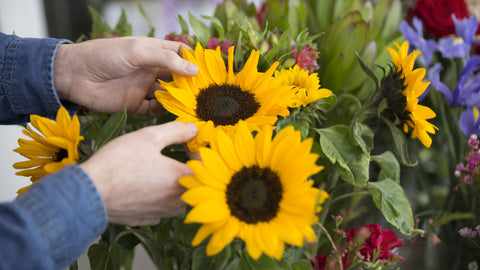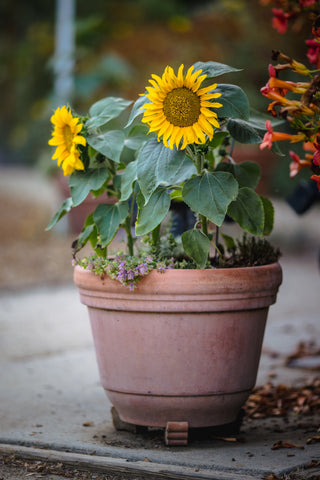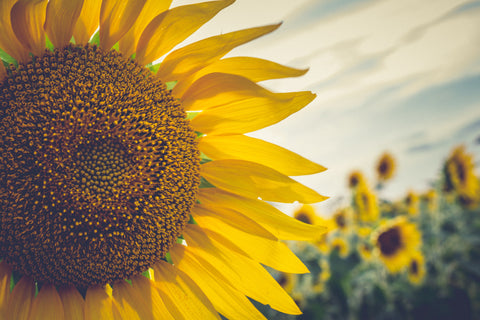How to Plant, Grow, and Care For Sunflower | Sunflower Seeds Benefits
Who doesn’t like growing the prettiest flowers in one’s backyard, right? Although a modern plant parent has a plethora of choices when picking from the abundant flowering varieties, certain old-school flowers are still among the most favorable bloomers across India! For instance, roses sit on the tip of our tongues whenever we are asked to name one flower, and daisies take over the fields of our minds when we talk of Spring! There’s another flowering beauty known for its vibrance and beauty - the sunflower plants! Consider this blog as a complete guide to growing sunflower plants at home and also know the benefits of Sunflower seeds.
What Is A Sunflower?
The sunflower flower belongs to Helianthus, known for its seventy blooming species in the daisy family. Helianthus is also the scientific name of sunflowers, through which these plants are recognized in the scientific gardening community. Almost all sunflower species originated from Central and South America, and some wandered around the globe searching for suitable spaces for their propagation. Very few people know that the sunflower tree has been planted in Ukraine for centuries, as it is the country’s national flower.
They can grow to a maximum height of one-twenty inches, and gardeners worldwide mostly propagate them in groups, creating eye-catching sunflower gardens. It grows tall with elongated stems colored green with a few sunflower leaves here and there, while the flowers imitate the appearance of daisies. If you could zoom out on a daisy plant, make it yellow with slightly larger petals, and add a fluffy brown center, that would look much like a sunflower.

These flowers are known for their intricate ability to follow the sun’s gaze throughout the day, inclining east to west with the sun’s pace during the bright hours. Later, they loyally turn back to the east to wait for the sun to shine for another day. It is in their basic nature to follow the sun, so this pattern gets affixed in their behavior till the growth of sunflower seeds in the brownish center. This to-and-fro movement is known as heliotropism and continues even on days when the sun is covered with clouds.
These flowers are hardcore lovers of the sun, and that’s why their Greek name Heliosanthos literally means ‘sunflower.’ Their dedication to the sun makes them a favorable pick for warm landscapes, ringing the bells for the sunflower season from the beginning of Spring in temperate climates! Different sunflower varieties are assigned different jobs, from becoming a cut-flower decoration to lending sunflower seeds, so apart from the decorative reasons, the species you choose can depend on other sunflower benefits you wish to reap!
How To Grow Sunflowers In India?
Growing sunflowers from seeds requires one to gauge the details of sunflower care and the essential guidelines that will assist you in maintaining a vibrant garden. Here’s all you need to know before preparing your garden for welcoming white sunflowers!
How To Plant Sunflowers?
1. Landscape Selection
One particular thing about sunflowers is that they like the sun’s warmth but not too much, meaning the weather outdoors should be warm enough to accommodate these decorative plant seeds, where temperatures range between twenty to twenty-eight degrees Celsius. The best time to plant sunflowers in temperate regions is during hot and long-lasting summers when the flowers will receive ample time and energy to thrive throughout the summer!
2. Sunshine Needs
The Mexican sunflowers have a notable fondness for the sun’s warmth, so they flourish best in landscapes receiving direct sunlight. They should never be placed in a shaded spot, which will hamper their heliotropic development. Settle them in a full-sun view where they will receive at least six to eight hours of unhampered sunshine. The continuous gaze of the fireball will keep them warm, vibrant, and joyous!

3. Soil Sampling
Check your backyard’s soil for proper nourishment before picking a sunflower for your garden. These bright flowers prefer a potting mix loaded with all the essential nutrients from nitrogen to magnesium. If the available soil is not up to the mark, you can alter its composition using boosters like garden manure, cocopeat, etc. These materials will enrich your backyard soil’s potency, making it more viable for propagating sunflowers! The soil’s pH should lie between six to seven point five for healthy growth.
4. Wind Shielding
These flowers are often taller than other flowering varieties, making them more prone to damage due to heavy winds. Therefore, it is essential for the sunflower gardeners to propagate them in a sheltered spot guarded by either fences or walls. Damaging a top-heavy sunflower will only take a few minutes of heavy breeze, so protect it from the unpredictable winds.
5. Pest Protection
Given the favorable quality of the sunflower seeds by humans and birds alike, they will likely get several visits by the wildlife. If you wish to consume the seeds, shielding the flowers from the birds is better. Moreover, insects like sunflower moths can seek residence in the leaves, but one can easily remove them manually from the plant. You can use natural pesticides for plants, like neem oil and insecticidal soaps, to safeguard them further.
How To Plant Sunflower Seeds?
One common question when you plant sunflower seeds is how deep to plant sunflower seeds, and the simple answer to this query is to propagate them at least one to one and a half inches deep, leaving a distance of about six inches between one seed to the other. The ray florets of sunflowers will require ample space to unfold, especially the ones that stay lowkey in their growth.

Moreover, you can ascertain your plant’s bright future by mixing chemical or organic fertilizers in the potting soil at the time of propagation; this will ensure the plant receives all the essential nourishment to grow robust roots that stay protected from heavy winds. After sowing seeds, one should also cover the area to shield it from the beautiful birds. Plus, if you wish to witness a longer cycle of sunflower blooms, better sow the sunflower seeds for planting in a span of five to six weeks!
When To Plant Sunflower Seeds?
Another interesting question that comes to mind is when to plant sunflowers. What is the ideal time to welcome these plants to our home gardens? The right time to begin a sunflower garden near me is after the cold days have passed and the spring knocks on our doors. These vibrant blooms require long periods of hot and warm days, so propagating them at the beginning of Spring will give them enough time to bloom and flourish till the end of the summer days!
How To Grow Sunflower Seeds?
Once you have propagated sunflower seeds in your backyard after the frost left the atmosphere, it’s time to give these seeds the best nourishment and care. You will witness the growth of seedlings after a few weeks of propagation. Once the seedlings start sprouting, mulch the area around the roots. Initially, hydrate the plants using a watering can near the roots and let the water sink in up to three to four inches.
Later on, ensure the watering schedules don’t hamper the plant’s growth due to overwatering, plus the plant’s base should largely stay protected from waterlogging. Hydration should always be generous, but it should not become compulsive, meaning only water the plant when the soil looks dry. One may further feed it with balanced chemical fertilizer to improve its nourishment quota and pave the way for successful growth. Your sunflowers will thank you for adding stakes, trellises, etc., to support their single stems.
What Are The Types Of Sunflowers?
Growing a flowering specimen like a sunflower is easy when you know which variety you want to accommodate in your garden. Here’s a list of all the top sunflower cultivars frequently propagated in the Indian subcontinent.

1. Autumn Beauty
This sunflower variety is known for its stunning blooms that grow from the edges of seven-foot-tall stems. This attractive cultivar appears gorgeous when propagated in groups of flower beds. The blooms range from yellow to bronze and mahogany!
2. Mammoth
Widely known for its humungous blooms that resemble the sun, this variety looks superb with delicate petals colored yellow. The sunflowers are a treat for the eyes, hanging on twelve-foot-long stems. Moreover, its seeds are known for their sunflower seeds nutrition as they are exceptionally tasty, and you can feed them to the birds using a bird feeder too!
3. Teddy Bear
This sunflower variety is a favorite of urban plant parents who lack the backyard space to propagate directly in the landscape. It grows only up to three feet tall, so one can easily propagate and maintain it in the floor planters. Nonetheless, its blooms are extremely attractive to the eyes with their fluffiness and bright yellow shade!
4. Sunrich Gold
If you are looking for a sunflower specimen perfect for a flower vase, your search literally ends here! This flowering plant is suitable to keep in bouquets and as cut-flower decorations that hang from the five-foot-tall stems. Its blossoms are rich in yellow and have a width of about four to six inches.
How Much Time Do Sunflowers Take To Bloom?
Although blossoms in the sunflower plants mainly depend on the type of cultivar you have propagated in your garden, one can rest assured that the plants will bloom after a growth period of seventy to one-twenty days. Different cultivars have different tendencies and height orientations, so we can’t give you a definite time, but given that most of these varieties are easy to grow, they all blossom in the coming time!
How To Harvest Sunflowers?
Many people across the country propagate sunflowers for one reason - sunflower bouquets. The sunflower botanical name ‘helianthus’ gets the most searches for its use as a home-cut flower decoration. The best way to utilize sunflowers for indoor decoration is by sniping the stems before the buds lead to side blooms.

This task should be accomplished in the early mornings; otherwise, the blooms can wilt. Use an easy branch cutter to remove leaves on the stems, but let the ones near the flower head remain. Also, cut the bottom of the stems at an angle of forty-five degrees before putting them in a water-filled vase, which should be accommodating enough to support the heavy blooms!
How To Harvest Sunflower Seeds?
The sunflower scientific name has also cumulated goodwill because it provides the human race with extremely beneficial seeds. These seeds can be quickly harvested at home for personal consumption, re-plantations, and bird feeding! The process begins with letting the flowers dry till they almost look properly decayed; this is also when the seeds will themselves get a bit loose from the center.
Remove the seed-filled head from the blooms using a sharp scissor, and put it in a container to store the already-loose seeds. Further, one can manually pick the leftover seeds from the plant’s brown head or use a fork. If this doesn’t work, rub the flower’s head on a surface like you would wash a cloth.
People often use sunflower seeds for roasting and consumption, making it essential to cover the flower heads throughout their blossoming duration with a protective cover fastened around the heads with a rubber band. One may also hang these flowerheads upside down inside the house to dry out without the threat of birds.
It is also suggested that you wash the seeds before layering them to dry for a few days. Also, these seeds will propagate more plants through them, so one can store a few in an airtight jar for future propagation!

What Are The Benefits Of Sunflower Seeds?
Numerous sunflower seeds benefits push us to grow these gorgeous plants at home and enjoy the health benefits that come with them! Here’s how these seeds, available at an affordable sunflower seeds price on Plantlane, can impact your well-being in a healthy manner:
1. Anti-inflammatory Benefits
Although inflammations are a necessary response of our bodies to treat the underlying infections, consuming these seeds along with chia and flax seeds will boost the anti-inflammatory response so that the body doesn’t end up experiencing chronic inflammations resulting in autoimmune diseases, cancer, diabetes, etc.
2. Healthy Heart
The uses of sunflower seeds in our regular diets can also change how our hearts work. They are strongly associated with reduced cholesterol and increased absorption of heart-healthy fats in these seeds, like monounsaturated and polyunsaturated fats.
3. Prevents Sickness
These seeds are an excellent storehouse of essential minerals and vitamins that promote immunity, reduce free radicals, and decrease the risk of contracting degenerative diseases. This fantastic quality of acting like a precautionary measure by reducing the chances of getting sick works wonders for all working and non-working people who seek a healthy lifestyle.
4. Aids Weight Loss
These seeds are loaded with protein and fibers that, when ingested, keep our stomachs full for a longer duration. Therefore, it’s almost impossible to overeat and mess with the diet after consuming these. Thus, these sunflower seeds uses will make you feel satisfied with your food intake, decreasing excessive eating, thereby pushing your weight loss journey even further!
5. Glowing Skin
These seeds naturally detoxify the body by removing harmful bacteria from our cells. This antibacterial and antifungal function checks our skin health by removing free radicals, forming collagen, healing wounds, and preventing scars. They work in our skin’s favor to purify glowing skin from the inside out.
6. Aids Pregnant Women
Sunflower seeds store significant Vitamin E, essential for aiding prenatal development. When the child forms in the womb, it requires a constant supply of Vitamin E to develop in a healthy way. Consuming these seeds during pregnancy is a vital step a pregnant woman can take for herself and her kid!
7. Ancient Usage
In the contemporary world, sunflower seeds are mostly associated with roasting and as a bird food. However, in the distant past, native Americans utilized sunflower seed oil for healing skin diseases, and the vibrant hue generated from the flowers can serve for dying clothes!

How To Eat Sunflower Seeds?
Once you have dried the sunflower seeds, it is time to re-soak them in salted water over the night. The next morning, strain them and dry them over paper. Spread them in single layers in the baking tray, and put the tray inside the oven for about thirty minutes at three hundred and twenty-five degrees. One should also stir the seeds during the baking process and bake them till they turn brown while staying vigilant enough not to let them burn. Season them with some salt and olive oil to make them taste more delicious, and they will be ready to snack. Moreover, you can feed them without the seasoning to the birds.
Take Away:
Sunflowers are widely propagated in India for their magnificent yellow to mahogany blooms that catch every eye! While some plant parents invite them inside the home to grace their interiors, others prefer letting them swing in the backyards, where they converse with the sun throughout their blooming season. A great advantage of propagating these flowers is that one can re-plant more of them through the seeds. If you wish not to propagate more sunflower beds, you can also benefit from the consumption of seeds by adding them to your diet. Whatever you choose, these plants will become the center of your backyard as soon as they bloom. What’s better is that they are available at reasonable prices in online gardening stores like Plantlane in India!
FAQs About Growing Sunflowers In India
Ques: How To Care For Sunflowers?
Ans: Your sunflowers will require a warm and comfy environment where the sun shines bright, and the wind doesn’t hamper their growth. With a well-draining soil enriched with nourishment and proper watering schedules, your sunflower garden will soon outshine.
Ques: When Do You Plant Sunflower Seeds?
Ans: The ideal time to sow the sunflower seeds is right after the frost has passed; the first days of Spring mark the propagation so the plants can get enough time to bloom with wonderful flowers.
Ques: Where Can I Place Sunflowers At Home?
Ans: One may cut the flowering stems at a 45-degree angle at the bottom and settle them in a water-filled flower vase. These cut flowers can be placed at a bright spot indoors.
Ques: How Long Will My Sunflowers Last In The Vase?
Ans: Cut the stems that are about to blossom into beautiful sunflowers so they will live for long in the vases. When done right, these blooms can last for up to twelve days.
Ques: Can I Store Sunflower Seeds For Propagation?
Ans: Yes, one may keep the seeds in a tightly sealed jar for future usage in the gardens.
Ques: Benefits of Sunflower Seeds?
Ans: Sunflower seeds help in heart health, weight management, bone health, skin health, digestive health and more.


